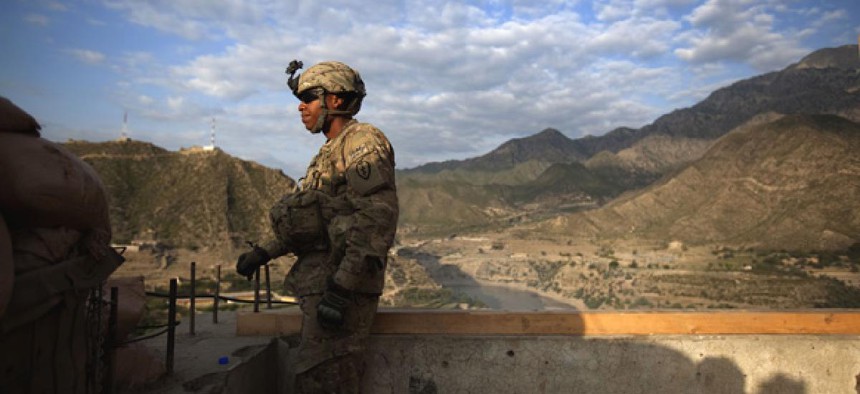
Pfc. Garrick Carlton keeps watch over an installment in Afghanistan. David Goldman/AP
Shootings likely to upend Afghanistan strategy
Tragedy steps up pressure to find a faster way out of the conflict.
Recent events in Afghanistan, including Sunday’s horrific shooting of Afghan civilians by a U.S. soldier, are not just going to alter U.S. strategy there. They are very likely to upend it. Even before the latest tragedy, President Obama was trying to expedite his way out of that quagmire, which is already the longest war in American history, as he faced a tough fight at home for re-election. Now Obama is likely to only speed things up further.
Obama’s 2014 withdrawal timetable depended on a gradual handover of control to Afghan troops by U.S. and NATO forces, possibly by mid-2013. But after it was revealed in February that U.S. troops burned old Korans as garbage, Afghans have been “fragging” their American advisors randomly and are not deemed nearly as reliable. Those tensions are almost certain to worsen dramatically following Sunday’s events, in which a U.S. soldier allegedly opened fire on sleeping Afghan civilians, including women and children, in their homes and killed at least 16. Gen. John Allen, for the second time in recent weeks, was forced to issue something close to an apology, saying he “was shocked and saddened” and offered his “profound regret.”
The Taliban have already vowed revenge for the killings, which are likely to encourage the Islamist insurgents to fight on rather than join negotiations that Washington has been pushing for in recent weeks.
The disintegration of the U.S. strategy in Afghanistan has been accelerated by historically poor relations with neighboring Pakistan, which supplies a safe haven to the Taliban that is far worse than anything the U.S. endured in fighting the insurgents in Iraq. Last month, Ryan Crocker, the U.S. ambassador to Afghanistan, sent a top-secret cable to Washington concluding that Taliban havens in Pakistan were jeopardizing the success of the U.S. strategy, The Washington Post recently reported. U.S.-Pakistan relations have been all but frozen by continuing fallout from the raid that killed Osama bin Laden last spring and errant NATO strikes that killed 24 Pakistani soldiers last fall. Many members of Congress are also fed up: Rep. Jim Moran, D-Va., who made a recent trip to Pakistan, told me recently he sees no hope of restoring trust.
Though the official line is that the U.S. withdrawal timetable is unchanged, some U.S. officials have begun to talk about speeding it up—in part because there are also positive developments that might make a faster pullout more feasible. First U.S. forces can do much more with less. Back in 2009, when the administration was engaged in an intense debate over adopting a troop-heavy counterinsurgency strategy versus a more narrowly focused counter-terrorism approach, U.S. covert capabilities, both from the air (armed drones) and on the ground (special ops), were not as finely honed as they are today. Led by close teamwork between CIA Director David Petraeus and Defense Secretary Leon Panetta, U.S. military resources are being directed toward covert “direct action” and special operations as never before. Obama and other U.S. officials are proudly pointing to the near-decimation of al Qaida's upper ranks. Despite growing moral objections to the U.S. drone campaign, administration officials will cite this success repeatedly during the presidential campaign as justification for a rapid drawdown of regular troops.
Some Obama administration officials are also convinced that the Obama “surge” of 30,000 additional troops, scheduled to be wound down by September, has left just enough stability on the ground, or what Petraeus has called "Afghan good enough" in the crucial part of the country called “regional command east.” As National Journal senior correspondent James Kitfield wrote in a perceptive assessment from Afghanistan in December: “Although they remain dependent on coalition ‘enablers’ such as airpower and logistics, Afghan security forces have increasingly shouldered the burden in RC East and kept the insurgents on the defensive.” But it is a fragile standoff: the 14 provinces of the east constitute more than half of Afghanistan’s total population of 30 million.
U.S. officials say, for the record, that nothing has changed despite new doubts about the reliability of Afghan security forces. Yet even the earlier U.S. timeline was considered ambitious given where Afghan security forces were in their development. Today plans for the handover, which are to be fleshed out at the NATO Summit in Chicago in May, remain completely unresolved. And there is a growing acknowledgement by Washington that “Afghan good enough” is going to mean leaving behind a quagmire, no matter what.
The harsh fact is that with a corrupt and weak civilian government in Kabul, meager Western forces, and a resurgent Taliban, the prospects are not much better than they were back in 2006, when I quoted a U.S. general saying, in an article called “The Rise of Jihadistan” that documented the resurgence of the Taliban, that the standoff between Afghan forces and the Taliban "could go on for 40 or 50 years …. this is going to be like the triborder region of South America, or like Kashmir, a long, drawn-out stalemate where everyone carves out spheres of influence."
An even harsher fact is that the United States missed what might have been its only real window of opportunity to transform Afghanistan nearly ten years ago, just after the fast ouster of the Taliban in December of 2001. George W. Bush elected instead to shift U.S. military focus on Iraq and recklessly left Afghanistan to fend for itself in what Bush’s own envoy, Jim Dobbins, called “the most under-resourced nation-building effort in history.”
For Obama, who is trying to run for re-election by portraying himself as a strong commander-in-chief, repeated apologies to Afghans and Pakistanis won’t play well at home in the middle of what is expected to be a close race. His chief rival, Mitt Romney, constantly accuses him of weakness and “apologizing for America.” Yet another planned U.S. apology—to Pakistan--was to have been delivered recently by high-ranking U.S. military and civilian officials, most likely by Joint Chiefs Chairman Martin Dempsey and Secretary of State Hillary Clinton, two U.S. officials told me. The statement of contrition, linked to an official Pentagon investigation that partially blamed mistakes made by U.S. forces for the NATO incident, was put off indefinitely after the Koran incident. But U.S. officials say they will probably need to deliver it if there is to be any hope of restoring U.S.-Pakistan cooperation.
All of which illustrates a tragic truth: even after ten years into this war, one that has cost nearly 1,800 U.S. dead, 15,000 wounded, and some $400 billion, forward progress is barely discernible and relations with America’s two chief allies, the Afghanistan and Pakistan governments, are worse than they have ever been. And that is why both administration officials and members of Congress are saying it’s time to go.







